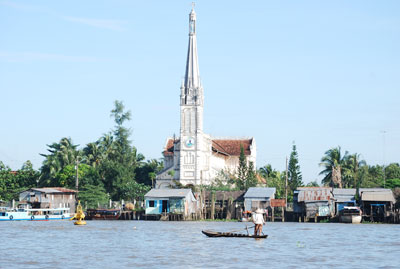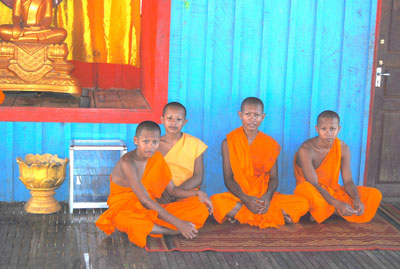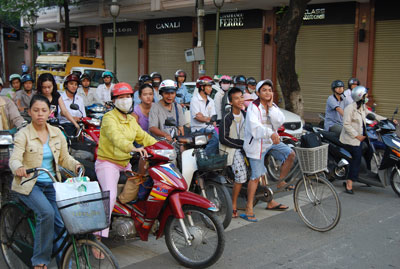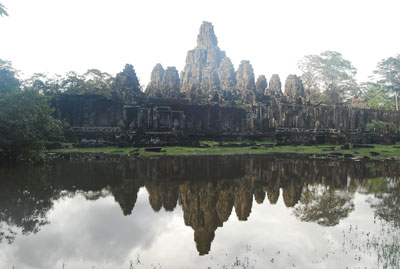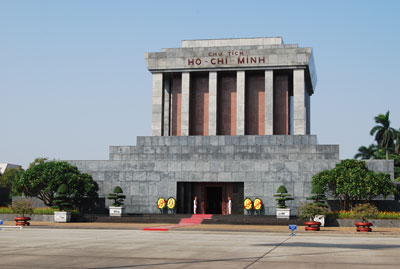Visiting Vietnam and Cambodia
by Ed Kinney, El Cerrito, CA
In the spring of 2008, my wife, Moreen, and I decided to travel to the Far East instead of what had become a frequent destination, the Middle East. To decide where, we studied articles in ITN and other publications before selecting Cambodia and Vietnam.
Angkor Wat was certainly a top priority, and we’d heard that both Saigon and Hanoi in Vietnam had resurfaced as popular travel destinations. Lastly, we didn’t necessarily want to jet between Cambodia and Vietnam, as flying restricts the opportunity to meet locals in nontourist areas, but with the rainy season approaching in Southeastern Asia (usually between June and October), we procrastinated in making our firm travel plans.
Fate intervened, however. Regrettably, Moreen died unexpectedly in July.
When I received a National Geographic Expeditions brochure in late August ’08 listing a 16-day tour, “Vietnam and Cambodia Along the Mekong River,” beginning Oct. 28, I signed on on impulse and quickly forwarded my passport for the required visas. In some way, I felt I would be fulfilling my wife’s wish.
Getting there
It’s a long flight to Cambodia, even for those of us living on the West Coast. It took nearly 15 hours to fly from San Francisco to Hong Kong on Cathay Pacific, followed by an 8-hour layover before continuing to Siem Reap, Cambodia, with Vietnam Airlines. The latter flight, requiring a plane change in Hanoi, took another five hours. Fortunately, all my flights departed and arrived as scheduled.
After clearing Customs and Immigration in Siem Reap, our group was met by our National Geographic Expeditions tour leader, John Freedman. His wife, Tina, had accompanied us from San Francisco and led us on a short tour of Hong Kong during the 8-hour layover. This extra tour ($150) was best suited for those who had never visited Hong Kong; regardless, it was better than sitting for eight hours in the airport.
Angkor
I crashed once I was in my room in the Raffles Grand Hotel d’Angkor. Morning was to come early for our first view of the most famous of the great temples of Angkor, Angkor Wat.
Due to temperatures of 90-plus degrees and high humidity, most tours begin early to avoid the midday heat. Photographers should note, camera lenses may fog over due to the high humidity and temperature differential between air-conditioned rooms and buses and the air outside. Whenever possible, I kept my camera covered and continuously wiped the camera’s protective UV lens filter with a soft cloth.
An entrance pass is required to enter the Angkor complex, comprised of 72 major temples and buildings built in an approximately 75-square-mile area. A 3-day pass costs $40. After being photographed, we each were quickly given an ID card, which was individually verified at each site we visited in the complex.
A hard morning rain didn’t spoil my first sighting of Angkor Wat. Walls protect the principle temple, with its inner walls portraying Hindu cosmology and its central towers representing Mount Meru, home of the gods. I agree with articles that describe Angkor Wat as the world’s greatest temple-city based on size and beauty.
That afternoon, under clear skies, our group visited two more Angkor sites in the Siem Reap area, Ta Prohm and Angkor Thom.
Space doesn’t permit detailed descriptions of these UNESCO World Heritage Sites, but I’ll add one strong recommendation: visit the excellent Angkor National Museum in Siem Reap. It is well worth the $12 admission fee. (All entrance fees for this tour were paid by National Geographic Expeditions.)
To appreciate Cambodia and its people, Expeditions arranged for Dr. Thina Ollier (Ph.D, University of California, Los Angeles) to give our tour group a series of four lectures on Cambodian history. I found her personal account of the Killing Fields most memorable.
Cruising the Mekong River
Leaving Siem Reap, our group boarded the RV Mekong Pandaw, anchored in Tonle Sap Lake. This required a 45-minute drive to the lake followed by a 30-minute water taxi ride between floating villages to our home for the next seven days.
The Mekong Pandaw is truly luxurious and beautiful, but, to me, its highlight was the ship’s crew, a blend from several Southeast Asian countries. All were very polite, efficient and friendly. Each time I entered the dining room, they quickly recognized my preferences — hot tea for breakfast and local beer for lunch and dinner — then they’d hand me the day’s menu with its fantastic offerings. Being in Southeast Asia, my choices were firmly local cuisine and I was never disappointed. There was usually at least one Western selection available.
Our cruise course was south toward Ho Chi Minh City, with detours en route. Frequently, we’d stop and go ashore to visit Cambodian and, later, Vietnamese villages, most of which were off the normal tourist route.
For our first of many visits ashore, a small water taxi came alongside the Pandaw while we were anchored in Tonle Sap Lake. The boarding was easy. The deck of the Pandaw and the taxi were on the same level, both five feet above the water. Nevertheless, Pandaw crew members always assisted us.
On this trip, we enjoyed a 45-minute boat ride on one of the many Mekong River tributaries, observing local Cambodian life. Our destination was the village of Kampong Chhnang, which basically translates to “terra-cotta port.” The terra-cotta pottery made in this village, mostly for cooking, has remained unchanged for centuries.
For our next shore adventure, the shallow-drafted Pandaw placed its bow on the riverbank, permitting us to simply step ashore. Our goal was the pre-Angkorian temple of Wat Hanchey, dating from the seventh century, on Hanchey Hill. It was either an “easy” 300-step climb up or you could hitch a ride on a bike up and back for $5. I opted to climb, stopping often to admire great views of the Mekong River below.
The best stop, later in Kompong Cham Province, was saved for last: a local orphanage supported by the Pandaw’s owners, the Irrawaddy Flotilla Company, and National Geographic magazine.
Our tour guide, John Freedman, had brought with us new bikes, wagons and school supplies for the children, who were mostly between four and 12 years old. It was a joy watching the faces of these kids as they took turns riding and helping each other play with the new toys. There was no scrapping or arguing among them!
In Phnom Penh, Cambodia’s capital, our morning tour began with a visit to the wonderful Royal Palace, Silver Pagoda and National Museum, all centered in one area. Those who have visited Thailand’s Royal Palace will see some similarity, but it was well worth the time to visit to appreciate Cambodian history.
Our next stop that morning was the Psar Thmei Central Market. An hour was way too short for taking photos and making purchases.
During this tour I didn’t convert a single dollar into either Cambodian riels or Vietnamese dongs. Everything was priced in US dollars for visitors.
Horrors revealed
The afternoon visits presented the realism of Pol Pot’s holocaust, in which millions of Cambodian’s were killed. A light afternoon rain didn’t wash away the horror of the S21 Genocide Museum, a complex formerly used as a detention-and-torture center by the Khmer Rouge regime.
One poignant sight was the positioning of S21 barbed wire, placed not to keep people from fleeing but to keep prisoners from jumping to their death in order to escape torture.
From the museum we drove a few miles outside Phnom Penh to the Killing Fields memorial at Choeung Ek. The interior floor of the memorial building is randomly stacked with skeletons removed from pits dug by the prisoners themselves before they were executed by the Khmer Rouge. Remains of bone and clothing can easily be seen in these pits, reinforcing the horrors of this genocide.
We then returned to the sanity of the Mekong Pandaw for a Cambodian folkloric dance performance.
Stops along the river
Our group continued south on the Mekong River, soon entering Vietnam. While the ship was at anchor, our entry papers were efficiently handled by the Pandaw’s purser.
Shortly thereafter we boarded a ferry for Chau Doc, a Vietnamese delta town on the Bassac River. Once ashore, each of us stepped into a waiting trishaw for a ride to the local market.
On our last full day aboard the Pandaw we again boarded water taxis, this time to visit Cai Be and its environs. Our first sighting of Cai Be was the distant steeple of an old French Gothic cathedral towering above the village’s floating market maze of boats. The cathedral’s reflection in the water became visible as we neared the pier.
French influence can be seen throughout Cambodia and Vietnam, and Vietnam is especially noted for its French cuisine.
Leaving the cathedral, we watched local entrepreneurs produce and package puffed rice cakes. Samples from the hot skillet were delicious.
In the afternoon we returned to our taxis to visit Binh Hoa Phuoc and the town of Vinh Long, where we wandered through the market. In market areas, particularly, I sensed that the Vietnamese were more aggressive than Cambodians.
Saigon and Hanoi
The crew of the Pandaw bid us good-bye as we boarded buses for our 2-hour drive to Saigon. The official name may have been changed to Ho Chi Minh City, but most still call it Saigon.
Our hotel was the excellent Caravelle, located within easy walking distance of Notre Dame Cathedral and the General Post Office. I leisurely explored these and other sights the next morning while some group members visited Cu Chi, the underground tunnels built by the Viet Cong.
Our time in Saigon was short, as our tour’s focus in Vietnam was Hanoi. We flew that same evening on Vietnam Airlines to Hanoi, where we were bused to the 5-star Sofitel Metropole Hotel, our home for three nights.
Our first morning tour began with a 45-minute cyclo ride through the Old Quarter market area of Hanoi. The 3-wheeled pedaled bike in which the passenger sits in front of the cyclist is popular for short rides. The fare is normally about $3. Since most cyclo drivers speak very little English, it’s best to have the hotel staff tell the driver your destination and agree upon a fare.
Off we went with 30 or so cyclos in a column, dodging pedestrians and motorbikes. This 45-minute ride ended at the north edge of Hoan Kiem Lake where, with the help of guides, we retraced part of our cyclo route on foot. The bike ride was more fun!
Later that afternoon, Expeditions arranged for us to have a private showing of a wonderful water puppet performance in the Truong Chinh Theatre. The show consisted of live performers in a shallow pool along with toy fish and ducks controlled by puppeteers behind gauze netting. Though the performers spoke Vietnamese, it was easy to understand each of the humorous plots due to the actors’ exaggerated performances.
Our last morning in Hanoi began by reviewing the life of Ho Chi Minh, the George Washington of modern Vietnam. The tour included visiting his mausoleum, which had on display a glass-covered open casket similar to Mao Tse-tung’s in Beijing.
Adjacent to this massive building, visitors are permitted to peer through windows into Ho Chi Minh’s simple but well-preserved home. The entire spacious complex area was extremely clean and well controlled.
Next we visited Vietnam’s Museum of Ethnology. Here, the highlight for me was not the museum or its dioramas but the number of couples being photographed on the surrounding grounds by professional photographers. Brides wore beautiful, long white Western-style dresses and the grooms, full formal attire.
For the last afternoon in Hanoi, many visited Hoa Lo Prison (aka the Hanoi Hilton). I opted to hire a cyclo. This permitted me to continue studying the culture and to view again many of the local sights we’d seen the day before but at my pace. My driver couldn’t speak English, but he knew the word “stop.” It was a great Vietnam finale!
Great dining
Earlier I discussed the excellent food served aboard the Pandaw, but I’d be remiss not to mention several great restaurants in Hanoi.
The night we arrived, our group ate at Restaurant Bobby Chinn (77 Xuan Dieu St.; www.bobbychinn.com). Its décor was unique — scattered rose petals on the tables and, on the walls, paintings depicting frogmen rising from the sea carrying AK-47s — but the food was excellent (although the menu’s editorializing was gauche). Best said, the owner has a weird sense of humor.
Two other restaurants in Hanoi deserve comment. One night, five of us taxied to the Seasons of Hanoi (95B Quan Thanh). A wonderful French dinner with wine cost about $25 each. Sinful desserts (extra) were out of this world!
And for our tour’s farewell dinner, we ate at the Wild Lotus Restaurant (55A Nguyen Du St.) — a wonderful dinner complemented by an open bar and Vietnamese musicians. It was a great place to say good-bye to fellow travelers and to especially thank John and Tina Freedman for their leadership.
I compliment National Geographic Expeditions (Washington, DC; 888/966-8687, www.national geographicexpeditions.com) for a wonderful tour. For specific information, visit the website, as they will be conducting this same tour in the fall 2009.
It is not the least-expensive tour of this area available, its price contingent upon cabin location aboard the Mekong Pandaw. With a lower-deck cabin on the ship, I paid $7,595 for the tour plus a single supplement of $1,700. The price included coach airfare from Saigon to Hanoi and most meals.
Considerable savings can be realized by using the Internet to get Cambodian and Vietnamese visas through the consulates instead of from Expeditions’ recommended Pinnacle TDS. Cambodia has a consulate in both Los Angeles and Seattle, and Vietnam has one in San Francisco.
My soliloquy
A Vietnamese guide told me there is no word in their language for “wife.” When introducing your wife, you’d say what translates to “This is my home.” I lost “my home” on July 16, 2008.


